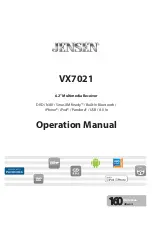
Chapter 1 OEM7 SPAN Overview
OEM7 SPAN Installation and Operation User Manual v14
26
Chapter 1 OEM7 SPAN Overview
NovAtel's Synchronous Position, Attitude and Navigation (SPAN
®
) technology brings together two very different
but complementary positioning and navigation systems namely Global Navigation Satellite System (GNSS) and
an Inertial Navigation System (INS). By combining the best aspects of GNSS and INS into one system, SPAN
technology is able to offer a solution that is more accurate and reliable than either GNSS or INS could provide
alone. The combined GNSS+INS solution has the advantage of the absolute accuracy available from GNSS and
the continuity of INS through traditionally difficult GNSS conditions.
The SPAN system consists of the following components:
l
NovAtel OEM7 receiver
These receivers are capable of receiving and tracking different combinations of GPS, GLONASS, Galileo,
BeiDou, NavIC and QZSS signals on a maximum of 555 channels. OEM7 receivers can also allocate chan-
nels for the reception of correction service signals from SBAS (standard) and TerraStar PPP (optional).
OEM7 adaptability offers multi-system, frequency, and size configurations for any application requirement.
Patented Pulsed Aperture Correlator (PAC) technology combined with a powerful microprocessor enable mul-
tipath-resistant processing. Excellent acquisition and re-acquisition times allow this receiver to operate in
environments where very high dynamics and frequent interruption of signals can be expected. The OEM7
receiver also supports the timing requirements of the IMU and runs the real-time INS filter.
l
IMU
The Inertial Measurement Unit (IMU) consists of three accelerometers and three gyroscopes (gyros) so that
accelerations along specific axes and angular rotations can be measured. Several IMU types are supported
and are listed in
l
GNSS antenna
The GNSS receiver is connected to the IMU with an RS-232, RS-422 or SPI link. A NovAtel GNSS antenna
must also be connected to the receiver to track GNSS signals. After the IMU enclosure, GNSS antenna and
appropriate power supplies are attached, and a few simple configuration commands are entered, the SPAN sys-
tem will be ready to navigate.
1.1 Fundamentals of GNSS+INS
GNSS positioning observes range measurements from orbiting GNSS satellites. From these observations, the
receiver can compute position and velocity with high accuracy. NovAtel GNSS positioning systems are highly
accurate positioning tools. However, GNSS in general has some restrictions which limit its usefulness in some
situations. GNSS positioning requires line of sight view to at least four satellites simultaneously. If these criteria
are met, differential GNSS positioning can be accurate to within a few centimeters. If however, some or all of the
satellite signals are blocked, the accuracy of the position reported by GNSS degrades substantially, or may not
be available at all.
In general, an INS uses forces and rotations measured by an IMU to calculate position, velocity and attitude.
This capability is embedded in the firmware of OEM7 receivers. Forces are measured by accelerometers in three
perpendicular axes within the IMU and the gyros measure angular rotation rates around those axes. Over short
periods of time, inertial navigation gives very accurate acceleration, velocity and attitude output. The INS must
have prior knowledge of its initial position, initial velocity, initial attitude, Earth rotation rate and gravity field.
Since the IMU measures changes in orientation and acceleration, the INS determines changes in position and
attitude, but initial values for these parameters must be provided from an external source. Once these para-
meters are known, an INS is capable of providing an autonomous solution with no external inputs. However,
because of errors in the IMU measurements that accumulate over time, an inertial-only solution degrades with
time unless external updates such as position, velocity or attitude are supplied.
















































